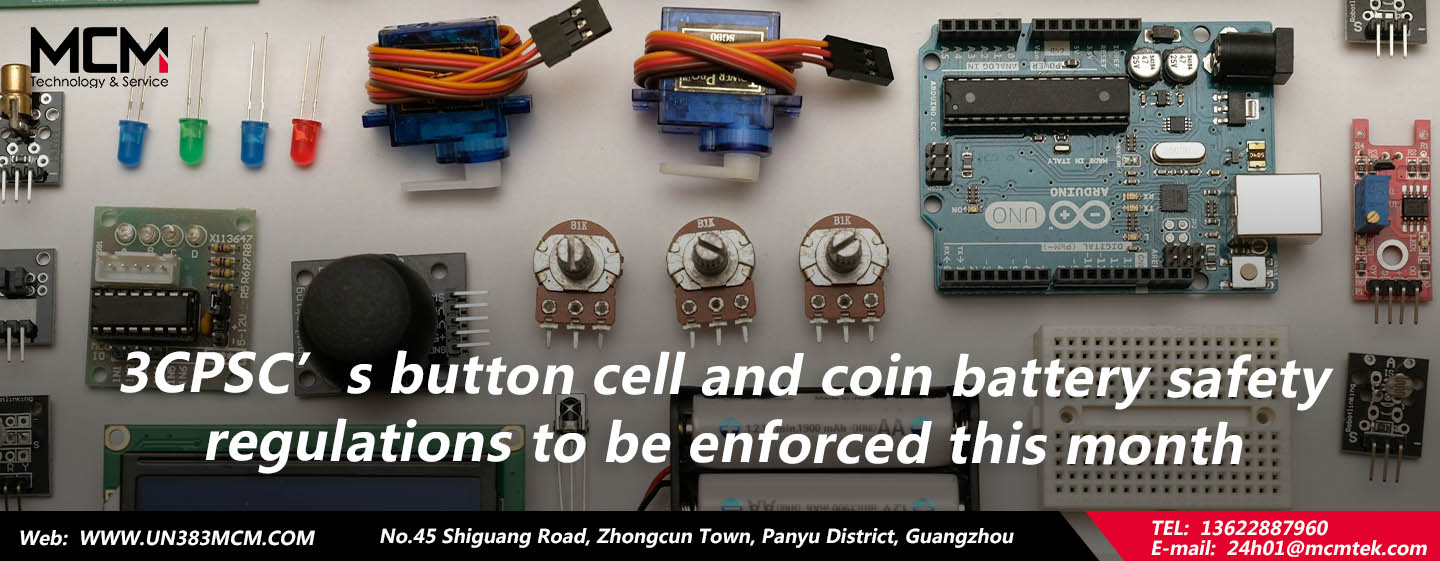The latest news
On February 12, 2024, the Consumer Product Safety Commission (CPSC) released a reminder document that the safety regulations for button cells and coin batteries issued under Sections 2 and 3 of the Reese’s Law will be implemented in the near future.
Section 2 (a) of Reese’s Law
Section 2 of Reese’s Law requires the CPSC to promulgate rules for coin batteries and consumer products containing such batteries. The CPSC has issued a direct final rule (88 FR 65274) to incorporate ANSI/UL 4200A-2023 into a mandatory safety standard (effective March 8, 2024). ANSI/UL 4200A-2023 requirements for consumer products that contain or are designed to use button cells or coin batteries are as follows,
- Battery boxes containing replaceable button cells or coin batteries must be secured so that opening requires the use of a tool or at least two separate and simultaneous hand movements
- Coin batteries or coin Battery cases shall not be subject to use and abuse testing that would result in such cells being contacted or released
- The entire product packaging must carry warnings
- If feasible, the product itself must carry warnings
- Accompanying instructions and manuals must contain all applicable warnings
At the same time, the CPSC also issued a separate final rule (88 FR 65296) to establish warning labeling requirements for the packaging of button cells or coin batteries (including batteries packaged separately from consumer products) (implemented on September 21, 2024)
Section 3 of Reese’s Law
Section 3 of Reese’s Law, Pub. L. 117–171, § 3, separately requires that all button cells or coin batteries be packaged in accordance with the poison prevention packaging standards in section 16 C.F.R. § 1700.15. On March 8, 2023, the Commission announced that it would exercise enforcement discretion for packaging containing zinc-air batteries subject to Section 3 of Reese’s Law. This period of enforcement discretion ends on March 8, 2024.
The Commission has received requests for extensions of both periods of enforcement discretion, all of which are in the record. However, to date the Commission has not granted any further extensions. Accordingly, the enforcement discretion periods are scheduled to expire as indicated above
Test items and certification requirements
Test requirements
|
Test items |
Product type |
Requirements |
Implementation date |
|
Packaging |
Button cells or coin batteries |
16 CFR § 1700.15 |
2023年2月12日 |
|
16 CFR § 1263.4 |
2024年9月21日 |
||
|
Zinc-air button cell or coin batteries |
16 CFR § 1700.15 |
2024年3月8日 |
|
|
Performance and labelling |
Consumer products containing button cells or coin batteries (general) |
16 CFR § 1263 |
2024年3月19日 |
|
Consumer products containing button cells or coin batteries (children) |
16 CFR § 1263 |
2024年3月19日 |
Certification requirements
Section 14(a) of the CPSA requires domestic manufacturers and importers of certain general-use products that are subject to a consumer product safety rules, to certify, in a Children’s Product Certificate (CPC) for children’s products or in a written General Certificate of Conformity (GCC) that their product(s) comply with applicable product safety rules.
- Certificates for products that comply with Section 2 of Reese’s Law must include references to “16 CFR §1263.3 – Consumer Products Containing Button Cells or Coin Batteries” or “16 CFR §1263.4 – Button Cell or Coin Battery Packaging Labels”.
- Certificates for products complying with Section 3 of Reese’s Law must include the citation “P.L. “117-171 §3(a) – Button Cell or Coin Battery Packaging”. NOTE: Root of Reese’s Law Section 3 PPPA (Poison Protective Packaging) Packaging Requirements Testing does not require testing by a CPSC-accredited third-party laboratory. Therefore, button cells or coin batteries that are individually packaged but included in children’s products do not require testing by a CPSC-accredited third-party laboratory.
Exemptions
The following three types of batteries are eligible for exemption.
1. Toy products designed, manufactured or sold for children under 14 years of age must comply with battery accessibility and labeling requirements 16 CFR part 1250 toy standards and are not subject to Section 2 of Reese’s Law.
2. Batteries packaged in accordance with the marking and packaging provisions of the ANSI Safety Standard for Portable Lithium Primary Cells and Batteries (ANSI C18.3M) are not subject to the packaging requirements of Section 3 of Reese’s Law.
3. Because medical devices are excluded from the definition of “consumer product” in the CPSA, such products are not subject to Section 2 of Reese’s Law (or the implementing requirements of the CPSA). However, medical devices intended for use by children may be subject to CPSC jurisdiction under the federal Hazardous Substances Act. Companies must report to the CPSC if such products pose an unreasonable risk of serious injury or death, and the CPSC may seek to recall any such product that contains a defect that poses a significant risk of harm to children.
Kind reminder
If you have recently exported button cells or coin batteries products to North America, you also need to meet regulatory requirements in a timely manner. Failure to comply with the new regulations may result in law enforcement actions, including civil penalties. If you have any questions about this regulation, please contact MCM in time and we will be happy to answer your questions and ensure that your products can enter the market smoothly.
Post time: Apr-16-2024


